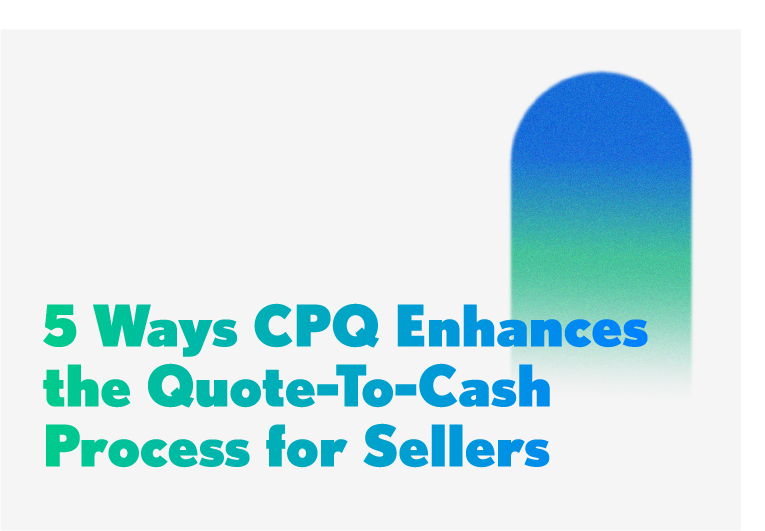To bring a vision to life, you need to have the right mission, the right plan, and most importantly, the right tools to do so.
With the value of configure, price, quote software increasing for sellers by the day, many are setting their sights on architecting their dream tech stack – one that can accommodate the nuanced preferences of a consumerized buyer, operate in omnichannel environments with ease and efficiency, and effectively future-proof against the inevitable market shifts to come.
When assessing the myriad CPQ solutions available, one provider consistently sets the standard for and meets the major needs of buyers, sellers and administrators alike – Salesforce.
Putting Salesforce CPQ at the core of your tech stack all but guarantees your ability to engineer a sophisticated sales environment inclusive of market differentiators that keep you at the head of the pack.
And further – our world-class commerce logic engine is native to the Salesforce platform, providing additional support, resources and features that allow you to more deeply customize your selling environment.
We’ve put together the quintessential CPQ cheat sheet, walking you through the dynamic duo that is Logik.io + Salesforce CPQ. It’s free to download through our resource library.
You may be starting to wonder what it is about Salesforce that leads to such strong brand recognition and customer confidence – and that’s exactly what we’re here to help break down for you.
While no CPQ tool can ever be fully perfect, Salesforce proves to be more than the sum of its parts – especially when augmented by Logik.io.
Architectural Benefits
Designating Salesforce CPQ as the scaffolding for your overall sales ecosystem means you get all the benefits of their core feature offerings, with additional potential to leverage partners like Logik.io for total customization.
The way Salesforce CPQ is architected aligns incredibly well with what customers report to be the three most important elements of customer experience: the ability to price and submit orders, dynamic configuration, and guided selling.
Salesforce allows administrators to designate a series of product rules that provide backend guidelines for order construction. Such rules can create recommendations, restrictions, or requirements that deploy in real time in relation to buyer input.
These rules subtly but effectively ensure that self-guided shoppers are submitting orders for the most appropriate, available inventory. Pricing information goes hand in hand with these rules and displays, as promotions, discounts, bundles, and complimentary offerings tie into the overall product rule architecture.
Supporting these rules through the process of buyer customization are a series of configuration attributes built into Salesforce CPQ. These attributes extend product rules to dynamic configuration scenarios in which specific conditions must be met to proceed, or certain configuration options negate/impact previous selections, ensuring that customers only create orders that can truly be fulfilled.
And impacting every step of the buying process is the guided selling technology within Salesforce. While online shoppers may want to be in the front seat, they are not subject matter experts on your products or services.
Guided selling questionnaires can gather real-time buyer input and use that data to present the just-right products or services for their needs. Here, buyers benefit from the knowledge and familiarity an in-person sales rep would provide through traditional channels, without having to compromise their eCommerce experience.
Manufacturing Cloud
As a result of the accelerated eCommerce development we’ve seen over the past three or so years, manufacturers have found themselves in a unique market position. Buyers, exposed to B2C storefronts that highly prioritize their time, comfort, and user experience, have internalized those expectations and now expect B2B interactions to follow the same structure.
These “consumerized” buyers are the new true north toward which manufacturers are setting their configure, price, quote compass.
CPQ for manufacturing is an entirely different beast than CPQ for B2C, due to the complexities of configurable products and discrepancies between line items on sales bills of material (BOMs) and manufacturing BOMs, among else.
Luckily, Salesforce has both observed and acted upon this paradigm shift, and established the Salesforce Manufacturing Cloud to specifically serve these businesses. With the Manufacturing Cloud, manufacturers can increase transparency through account planning and forecasting features, integrate directly into ERP solutions, gather and analyze customer interaction data, and so much more.
We wanted to know: are manufacturers successfully acclimating to this new environment and satisfying their target demographic? So, we commissioned a survey of 250 industry leaders to find out. You can download the full state of the market data report.
This directly results in solutions that bring eCommerce for manufacturing to an elevated level, providing better holistic experiences for sellers, producers, and buyers alike.
Partners and Peers
As proud as we are to be native to Salesforce, we are in no means alone when it comes to the amount of Salesforce-inclusive and -adjacent companies in our orbit.
For example, we can take a look at Zilliant: a pricing and sales cloud-native software company of strong renown. In early 2017, Zilliant announced its own integration with Salesforce CPQ to simplify quote-to-cash experiences, expand their reach in the B2B sphere, and provide strategic support for businesses looking to dial in their overall sales.
Another familiar name that has made its way into the Salesforce-partnered family is DocuSign, which deals in digitized documents, signatures, agreements and contracts. DocuSign Gen for Salesforce was created as part of the DocuSign Agreement Cloud to allow for seamless, efficient document creation and formatting without having to exit the ecosystem.
Read about the ways Logik.io Commerce Engine has enabled Fike Corporation to reach unparalleled success within the Salesforce ecosystem in our latest press release.
While Salesforce has one of the best entry-level software packages of notable CPQ vendors, their strengths don’t start and end within their own walls. Because of the wide breadth of integrations available, just about any seller can take configuration into their own hands, and create a tech stack inclusive of exactly what they need.
With a deeply saturated eCommerce market, buyers want to patronize the businesses that best serve their needs, accommodate their wants, and do so with as little stress and disruption as possible. Making the choice to base your ecosystem around Salesforce, and augmenting the standard software with our commerce logic engine, puts you in the best place possible to be that business.


